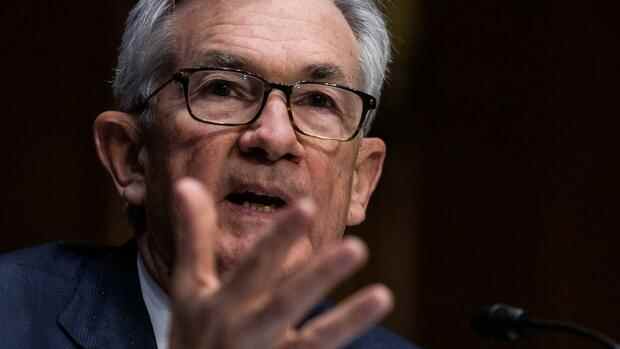New York, Dusseldorf Central bank boss Jerome Powell is rarely so clear: America’s leading central bankers are basically “of the opinion that we could raise interest rates in March,” he emphasized at a press conference in Washington on Wednesday. He left interest rates at a record low near zero, but the Fed’s pace is set to change significantly soon.
Powell has delayed this step for a long time. But due to persistent inflation, the Fed will act now. The next meeting of the central bank is scheduled for mid-March and it is likely to follow up several times over the course of the year.
The Fed is assuming that the economic data may be somewhat weaker due to the spread of the Omicron variant. But that is probably only a temporary effect. The job market is tremendously strong, Powell said, and will remain strong for quite some time.
A prerequisite for an interest rate hike is the halt to the major asset purchase program introduced during the pandemic, the end of which has now been sealed by the Fed. The monthly rate of reductions in acquisitions has already doubled to $30 billion as of mid-January. This maneuver, known as tapering, is to be completed at the beginning of March.
Top jobs of the day
Find the best jobs now and
be notified by email.
The reason for the Fed’s change of course is the rapid rise in prices. In December, US consumer prices rose 7 percent, the fastest in almost 40 years. This is the first time since June 1982 that there is a seven in front of the decimal point.
The stock markets initially said they were relieved that there was no monetary policy surprise on Wednesday. However, Powell’s remarks at the press conference caused turmoil on Wall Street.
Powell created room for monetary policy decisions this year – especially on the upside. The Fed chief pointed out that this time the US economy is “in a completely different situation than when interest rates were last turned around in 2015”.
With an unemployment rate of 3.9 percent, the labor market is now practically at full employment. The economy is growing strongly and inflation “is well above our long-term target.”
He did not rule out that the Fed could raise interest rates more than four times this year. A double increase of 0.5 percentage points is not off the table either. “There’s quite a bit of room for rate hikes without hurting the job market,” Powell said. Michael Feroli, chief economist at JP Morgan Chase, believes the Fed chairman has never acted so strongly as a hawk. He would clearly be pursuing a tougher monetary policy strategy than before.
Also read:
The Fed also said on Wednesday that it would begin to unwind inflated balance sheets shortly. Expiring bonds should then no longer be completely replaced from their portfolio. Liquidity is withdrawn from the market.
In a separately released statement, central bankers made it clear that they intend to shrink the balance sheet “over time and in a predictable manner.” This should be done in such a way that the Fed’s most important goals of ensuring full employment and price stability are not jeopardized.
All monetary watchdogs agree on this. However, the Fed left details open. She emphasized that she wanted to retain a certain degree of flexibility in order to be able to take account of developments in the economy and on the financial markets.
“Powell must not lose his nerve”
There is a passionate discussion about the right course in monetary policy. “Powell must not lose his nerve. He needs to raise rates slowly, even when inflation is high,” said David Kelly, economist at JP Morgan Asset Management.
If the Fed hikes rates too quickly and causes a recession, “they’ll never get around to reducing their balance sheets and raising rates.”
But not everyone sees it that way. Allianz chief economic adviser Mohamed El-Erian fears the Fed missed a key opportunity on Wednesday and is now falling further behind in its fight against inflation. El-Erian has been calling for the US Federal Reserve to end its ultra-loose policy for many months.
“The market is now expecting more rate hikes than before the meeting,” El-Erian said on CNBC. Wednesday’s losses would not suggest investors are calling for Powell to slow down. “I rather believe that they would have wished for more clarity,” said the economist.
Fear dominated the markets for days. Some investors used this to make additional purchases.
(Photo: Reuters)
The US Federal Reserve had massively underestimated the development of inflation at the beginning of last year. Now she is under pressure to take stronger countermeasures. In the run-up to the central bank meeting, market experts therefore expected the Fed to raise interest rates four times this year. Even more increases could be possible.
Powell had long held that prices would quickly return to normal. But the bottlenecks in the supply chains persist. Powell believes there could be some progress in supply chains in the second half of the year, which would then also dampen inflation somewhat. Less stimulus is also to be expected from the fiscal side.
Successfully roll back measures
Fed Chair Powell has received much praise for his determination to stabilize markets and the US economy early in the pandemic. In his second term of office, which will begin shortly, it will be a question of successfully rolling back these measures and preventing the economy from overheating. This mission is significantly more difficult.
“It is a classic mistake in monetary policy to react too vigorously and too late,” says economist Kelly. “It’s like driving on ice.”
More: Why the fear in the markets could be overdone
